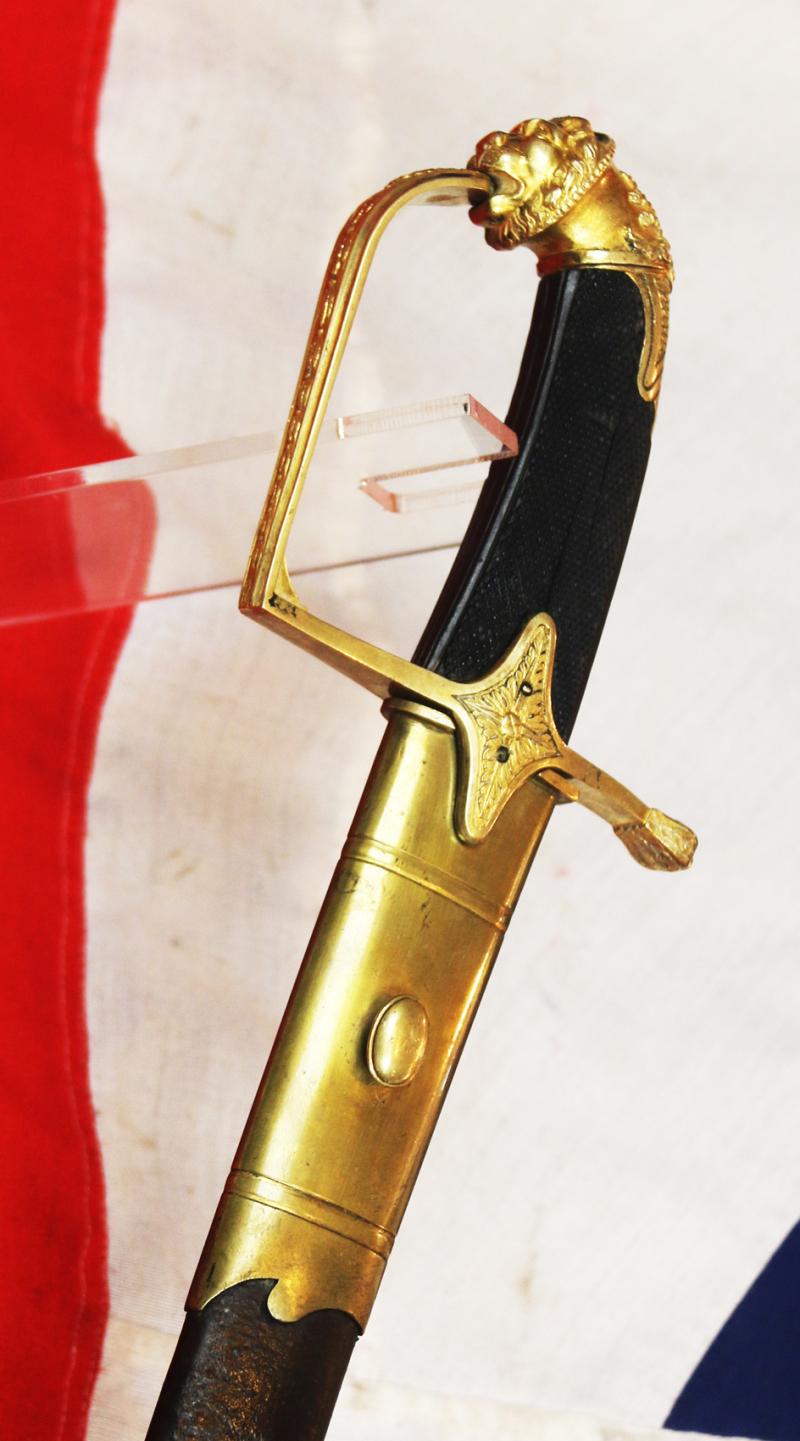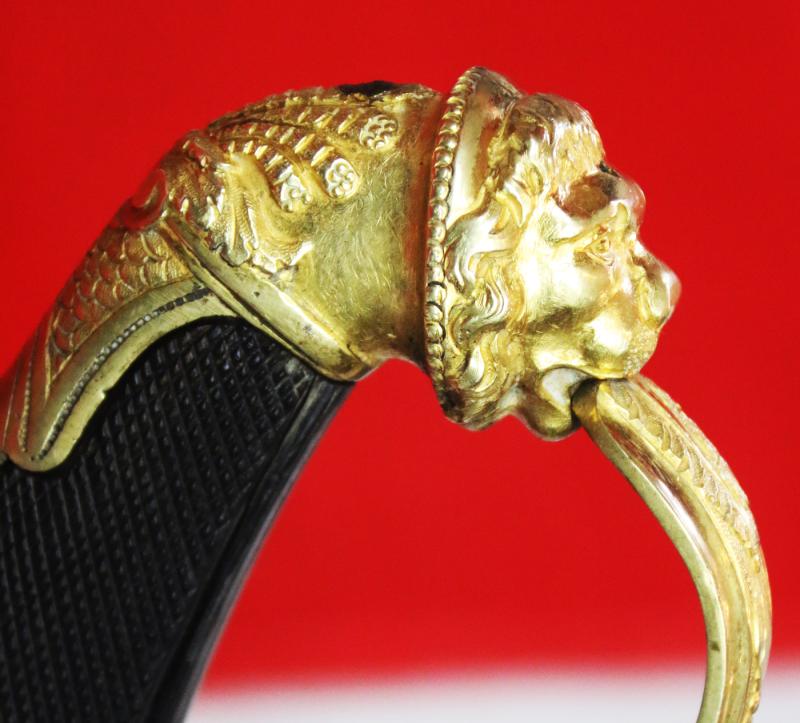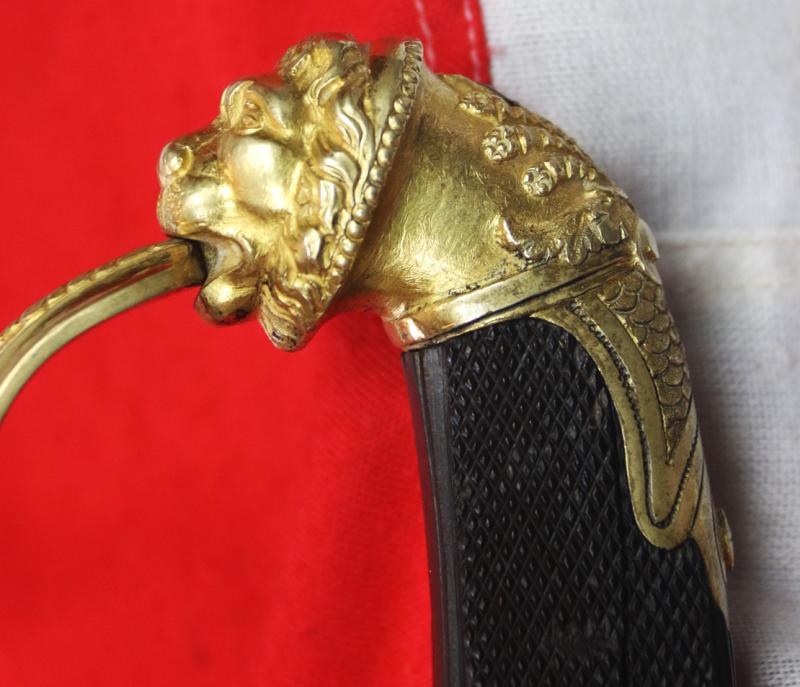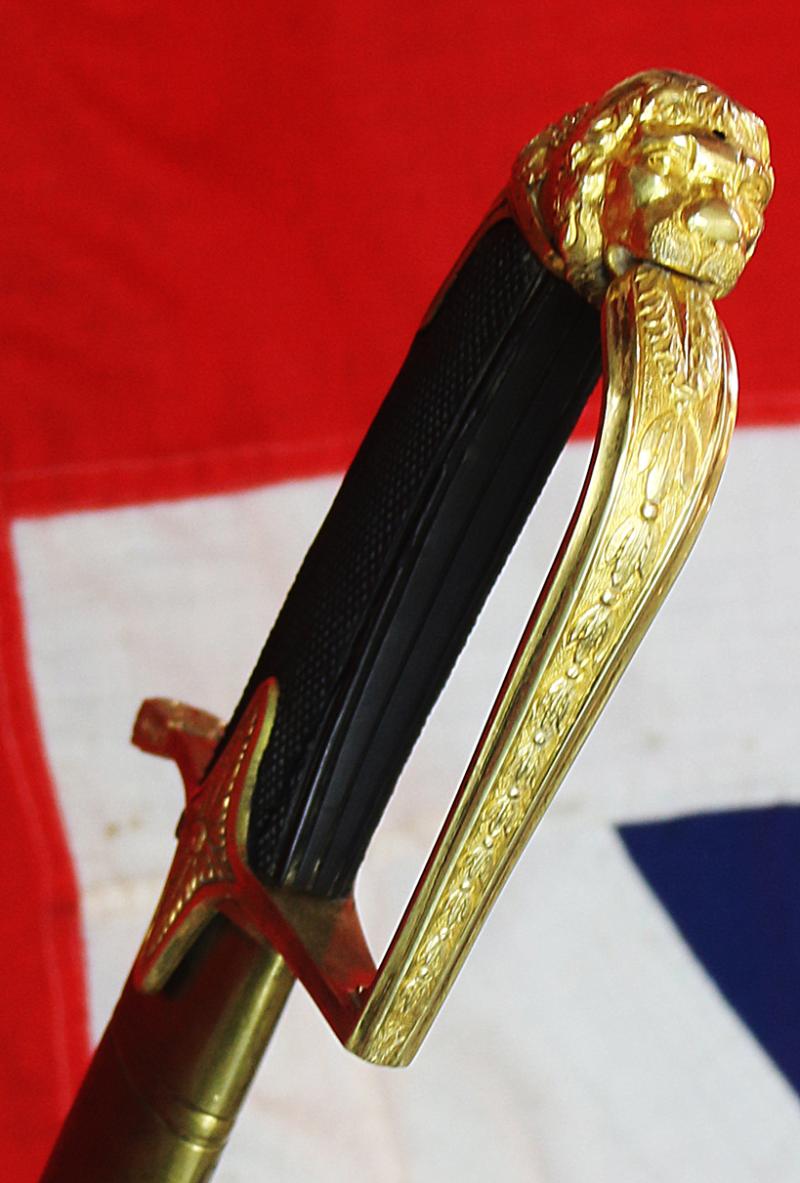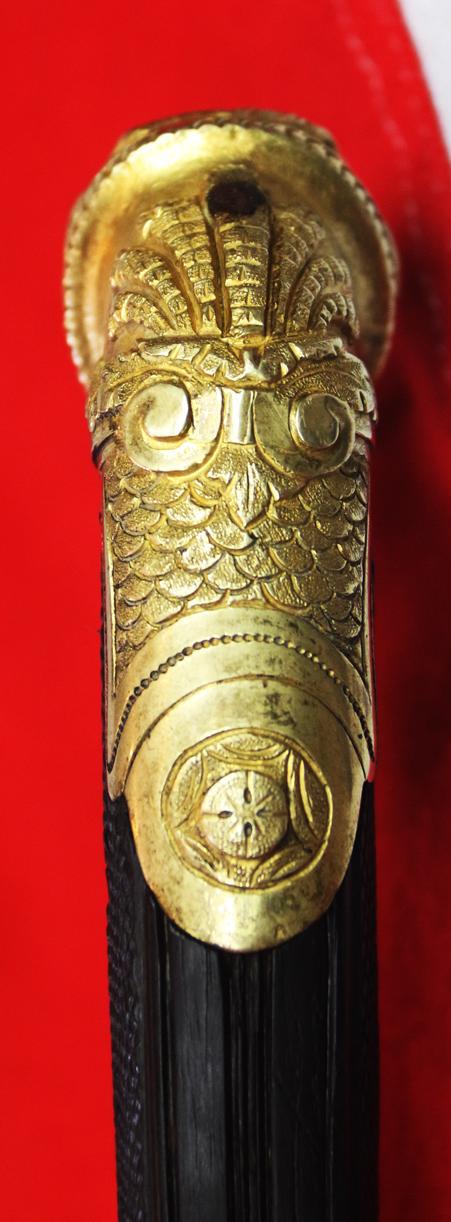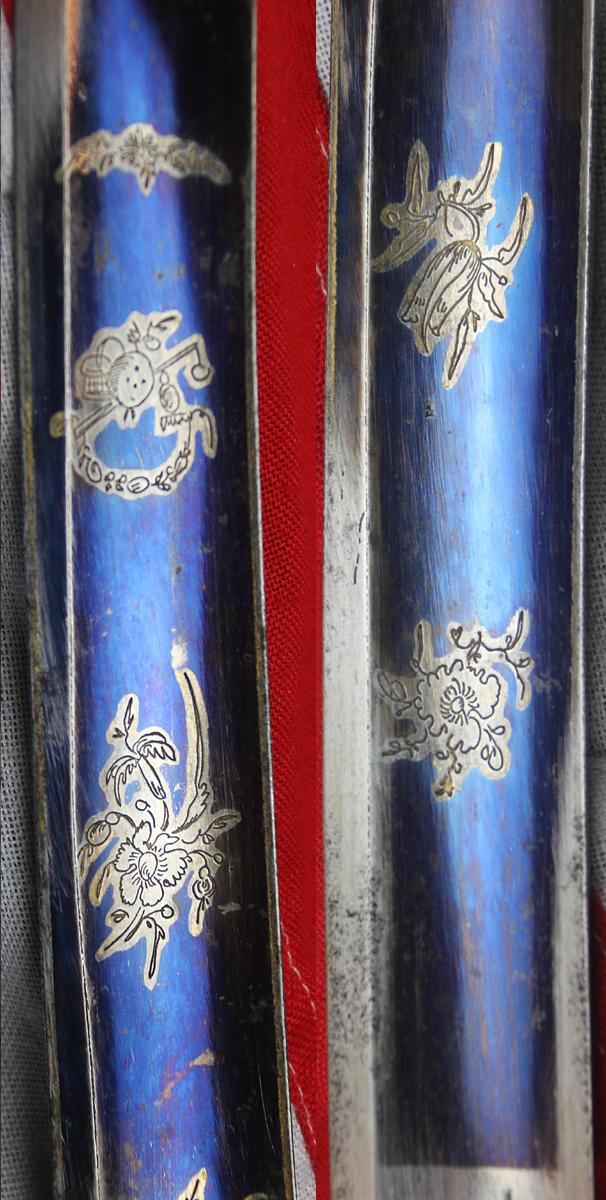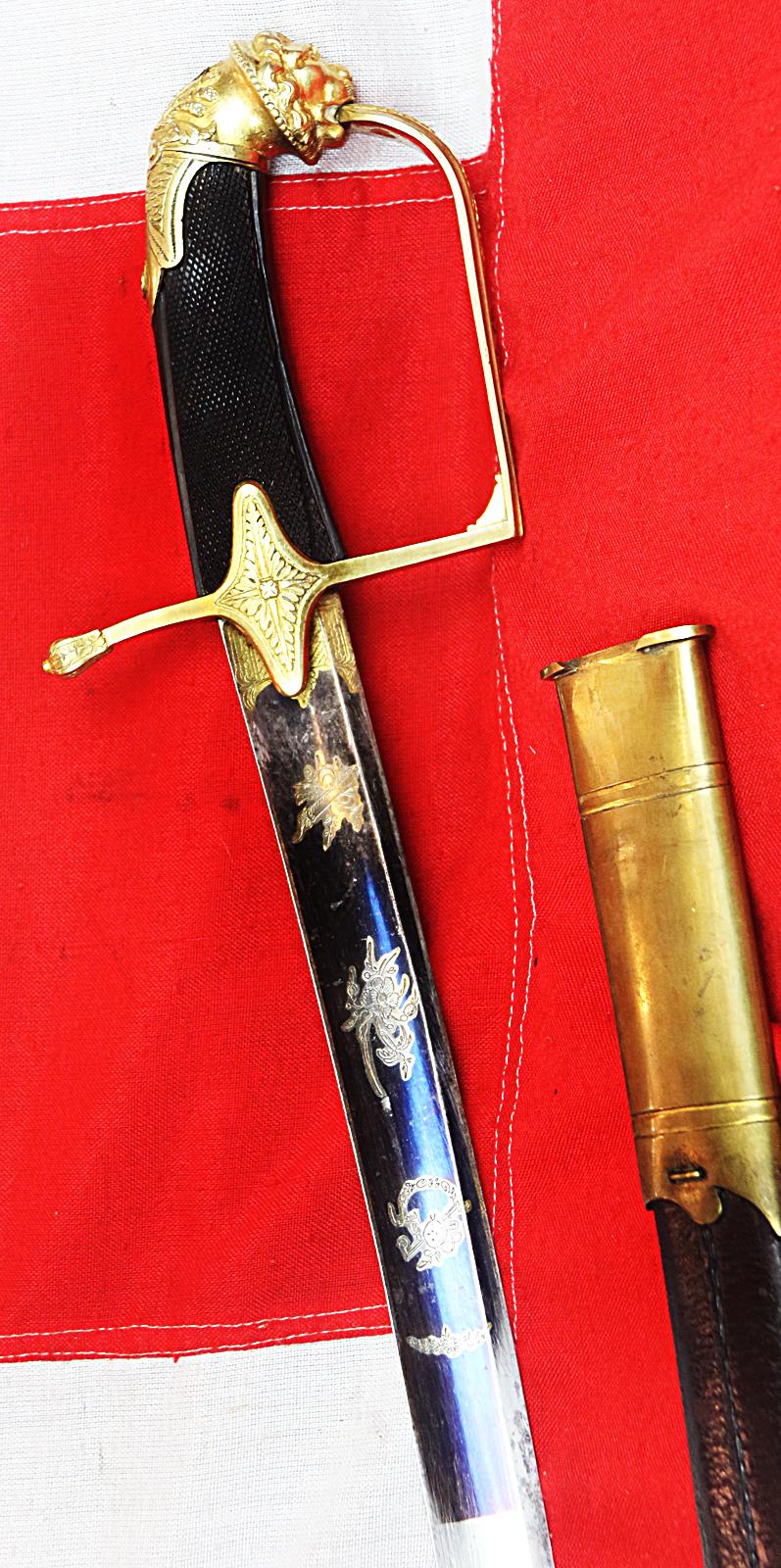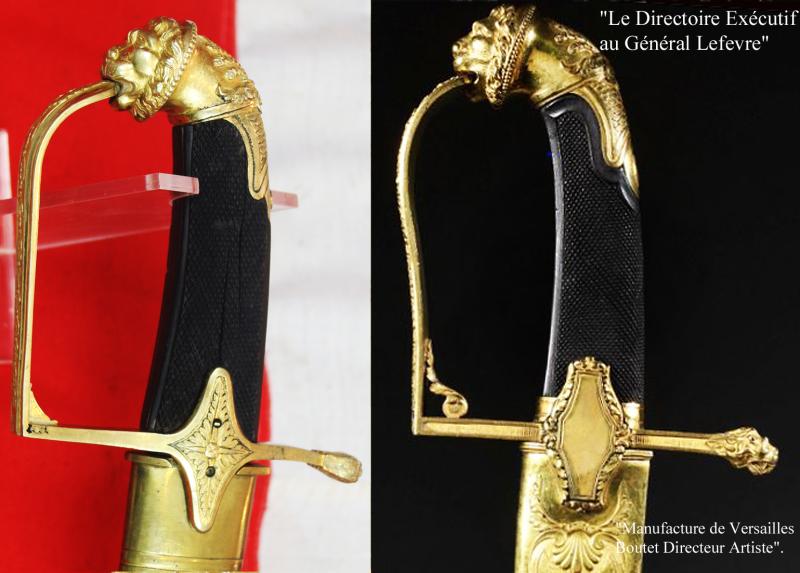A Stunning Directoire Period French Blue and Gilt ‘Award’ & Imperial Garde Grade Sabre of a General or General Staff Officer, Probably By Boutet Director of Versailles. Napoleon's Personal Sword Maker
Gilt bronze mounting, engraved and chased. Round-backed ebony handle with fine chequering. Short-skirted lion's head pommel chased with feathers and scales. Single-branch hilt decorated with oak leaves and acorns, cruise with two chased auricles in a row around the edge, straight quillon ending in a lion's head. Curved, superbly engraved deluxe blue and gilt flat-backed blade, Infantry style scabbard with frog mount in copper gilt with leather in superb condition.
We show in the gallery a most similar sabre, by Boutet of the Versailles workshop, presented to General Lefebvre by the executive board of the French Directory before Napoleon declared himself emperor, another very similar sword was used by Marshal Davout {see his portrait}, The workmanship of the hilt is so fine and similar to Lefebvres Boutet presentation sabre that we presume this fabulous sabre was likely also made by Boutet at Versailles.
The Directory (also called Directorate, French: le Directoire) was the governing five-member committee in the French First Republic from 26 October 1795 (4 Brumaire an IV) until October 1799, when it was overthrown by Napoleon Bonaparte in the Coup of 18 Brumaire and replaced by the Consulate. Directoire is the name of the final four years of the French Revolution. Mainstream historiography1 also uses the term in reference to the period from the dissolution of the National Convention on 26 October 1795 to Napoleon's coup d'état.
This sword would have been used and carried in combat by one of those officer's on Napoleon's general staff. Napoleon was, and remains, famous for his battlefield victories, and historians have spent enormous attention in analysing them.
Napoleon had numerous general staff officer's. However, a general in the field would have a relatively smaller cadre of officers supporting them.. Whether they were on Napoleon's staff or the staff of a general, their function was the same, to gather reports from field officers, précis them and ensure Napoleon and the generals have the right information. Then take Napoleon's or the general’s high level orders and ensure they get to the correct field officers, which may mean encoding them by hand.
Manage all the logistics, ensure that all the units are supplied with food, equipment and munitions.
In 2008, Donald Sutherland wrote:
The ideal Napoleonic battle was to manipulate the enemy into an unfavourable position through manoeuvre and deception, force him to commit his main forces and reserve to the main battle and then undertake an enveloping attack with uncommitted or reserve troops on the flank or rear. Such a surprise attack would either produce a devastating effect on morale, or force him to weaken his main battle line. Either way, the enemy's own impulsiveness began the process by which even a smaller French army could defeat the enemy's forces one by one.
After 1807, Napoleon's creation of a highly mobile, well-armed artillery force gave artillery usage increased tactical importance. Napoleon, rather than relying on infantry to wear away the enemy's defences, could now use massed artillery as a spearhead to pound a break in the enemy's line. Once that was achieved he sent in infantry and cavalry. The Napoleonic Wars brought radical changes to Europe, but the reactionary forces returned to power and tried to reverse some of them by restoring the Bourbon house on the French throne. Napoleon had succeeded in bringing most of Western Europe under one rule. In most European countries, subjugation in the French Empire brought with it many liberal features of the French Revolution including democracy, due process in courts, abolition of serfdom, reduction of the power of the Catholic Church, and a demand for constitutional limits on monarchs. The increasing voice of the middle classes with rising commerce and industry meant that restored European monarchs found it difficult to restore pre-revolutionary absolutism and had to retain many of the reforms enacted during Napoleon's rule. Institutional legacies remain to this day in the form of civil law, with clearly defined codes of law an enduring legacy of the Napoleonic Code.
While Napoleon is best known as a master strategist and charismatic presence on the battlefield, he was also a tactical innovator. He combined classic formations and tactics that had been used for thousands of years with more recent ones, such as Frederick the Great's "Oblique Order" (best illustrated at the Battle of Leuthen) and the "mob tactics" of the early Levée en masse armies of the Revolution. Napoleonic tactics and formations were highly fluid and flexible. In contrast, many of the Grande Armée's opponents were still wedded to a rigid system of "Linear" (or Line) tactics and formations, in which masses of infantry would simply line up and exchange vollies of fire, in an attempt to either blow the enemy from the field or outflank them. Due to the vulnerabilities of the line formations to flanking attacks, it was considered the highest form of military manoeuvre to outflank one's adversary. Armies would often retreat or even surrender if this was accomplished. Consequently, commanders who adhered to this system would place a great emphasis on flank security, often at the expense of a strong centre or reserve. Napoleon would frequently take full advantage of this linear mentality by feigning flank attacks or offering the enemy his own flank as "bait" (best illustrated at the Battle of Austerlitz and also later at Lützen), then throw his main effort against their centre, split their lines, and roll up their flanks. He always kept a strong reserve as well, mainly in the form of his Imperial Guard, which could deliver a "knockout blow" if the battle was going well or turn the tide if it was not.
Overall the condition is stunning. Especially the original mercurial gilt on the hilt and the blue and gilt decor on the blade In the 20th century generals plotted campaigns and were not often in the thick of combat. In the Napoleonic wars era general staff officers fought, more often than not alongside their men in hand to hand combat, hence, Napoleon lost so many of his general staff officers.
The chequered ebony grip has narrow splits on both sides, but otherwise excellent. The outside quillon has two small holes, this would have been for a small silver cartouch mount of Napoleon's bust profile, used by the privilege of status, by very special grade officer's. It may have been removed in the restoration period of 1814, in order to show the officer removed his previous connection to Napoleon {in order to preserve his current service and thus his senior status in France post Napoleon, before the 100 Days of Napoleon's return from Elba}.
Code: 25317
6250.00 GBP



